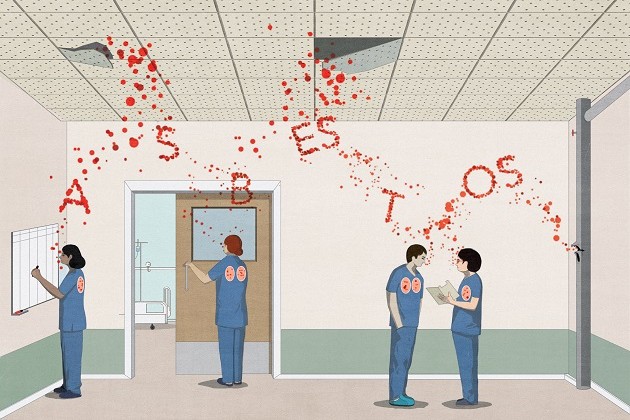While there’s a common assumption that asbestos is a hazard of the past, the substance has left a toxic legacy in public buildings, including many hospitals.
As a result, this is very much a live and important issue for the RCN, says Leona Cameron, Head of Health, Safety and Wellbeing, with us campaigning both to raise awareness and protect health care workers from potential deadly harm.
“Asbestos was banned from use in 1999, so a lot of people think it’s a problem that belongs in the past. There’s shock that it’s still an issue,” says Leona. “But there are vast numbers of health and social care buildings that still contain asbestos. It was seen as a miracle material, and such a good fire retardant and insulator it was used far and wide.”
Uses include partition walls, lagging on pipes and boilers, decorative features, floor tiles and cement roof panels, including soffits, gutters and downpipes. It was extensively used in the construction of public buildings in the 1950s to 1990s alongside reinforced aerated autoclaved concrete (RAAC). Now, as remedial works are carried out on RAAC due to the risk of building collapse, there’s also a risk of disturbing and damaging asbestos. The same risk exists should RAAC planks crumble.
We’re seeing an increase in nurses being diagnosed with mesothelioma
Problems arise when asbestos isn’t kept in good condition. “If you disturb asbestos, there’s a danger that its fibres will be released,” explains Leona. If these are then inhaled, it can lead to mesothelioma, which is incurable, or other asbestos-related illnesses.
Nationally, there are around 5,000 deaths each year related to asbestos, with symptoms taking between 10 and 50 years to appear.
A backlog of maintenance in the NHS is a big concern. “We have a deteriorating estate,” says Leona. “And if you’re doing maintenance work and don’t know there’s asbestos, there are some real risks. We don’t want to frighten people, but we’re already seeing an increase in the number of nurses being diagnosed with mesothelioma. It begs the question, if they’re not working directly with asbestos, why are they becoming ill? People automatically think construction workers may be at a higher risk, but very few will equate it with the state of the building they’re working in.”
How can nursing staff manage their risk?
- If you’re working in a building that was built before 2000 or refurbished before then, be aware it may contain asbestos, says Leona. “Buildings constructed between the 1950s and 1970s are especially likely,” she says. “It’s important to find out what state your building is in too. If it’s well maintained, the risk is lower.”
- If maintenance work is planned, there should be a risk assessment carried out first, with strict controls in place so no one is potentially exposed, says Leona. “Don’t be afraid to ask questions and don’t be fobbed off,” she says. “The risks are very real, for patients too.”
- Staff should have asbestos awareness training on what it is, the risks, where it’s located and how it should be managed. “But it seems that it rarely happens,” says Leona.
- Raise any concerns through your management chain, and by contacting your RCN rep or the RCN directly, advises Leona: “Ask to see your organisation’s asbestos management plan.”
In the summer of 2023, the RCN published a position statement on asbestos in health and social care buildings. It says research into deaths from mesothelioma suggests nurses experienced approximately twice the number of deaths than would be expected from typical asbestos fibre concentrations, where asbestos-containing materials were in good condition.
Freedom of Information requests by the charity Mesothelioma UK have discovered discrepancies between Office for National Statistics data on deaths of NHS staff due to mesothelioma, and NHS claims data for negligence that had resulted in mesothelioma.
Those in charge of buildings should have a register of where any asbestos can be found, with specialist surveys carried out as necessary. “It’s really important it’s identified,” says Leona. “If it’s not known whether asbestos is present, there should be an assumption that it is and a precautionary approach taken.”
The risks are very real for patients too
In 2022, the cross-party Work and Pensions Committee made clear recommendations on managing asbestos. However, the UK government rejected both the setting of a 40-year deadline for its removal in non-domestic properties, and a central register of where it is in public buildings.
“There’s a reasonable amount of backbench support across the House of Commons for the committee’s recommendations, with overwhelming support from trade unions and professional bodies,” says Dominic Trendall, RCN Public Affairs Advisor.
The RCN is also interested in discussing liability, with a view to improving the process for those who are seeking compensation from their employer. “The first connection between asbestos, cancer and ill-health was made in 1923, long before it was banned in 1999. Employers could have acted far earlier,” says Dominic.
What is the RCN calling on the UK government to do?
- Provide funding to tackle maintenance backlogs in NHS buildings.
- Mandate the phased removal of all asbestos in health and social care premises, over a 40-year period, with priority for asbestos in poor condition and in public areas, or areas easily accessed by workers.
- Fund the phased removal of asbestos in public buildings where health and social care services are delivered.
- Fully resource the Health and Safety Executives in both Great Britain and Northern Ireland to inspect NHS and independent sector health and social care buildings, taking enforcement action as necessary.
- Develop a publicly available digital register of asbestos for public buildings.








